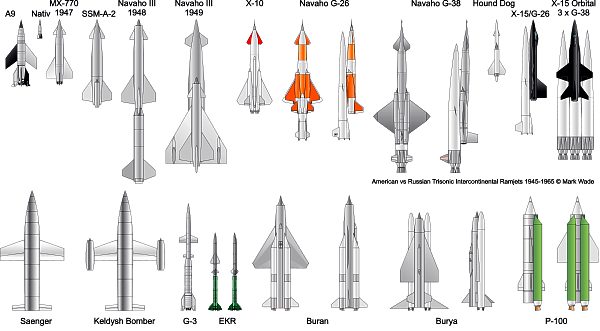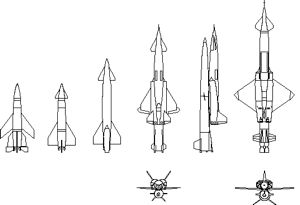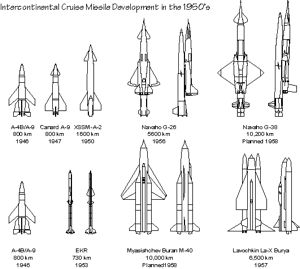Navaho X-10 (original) (raw)

Home - Search - Browse - Alphabetic Index: 0- 1- 2- 3- 4- 5- 6- 7- 8- 9
A- B- C- D- E- F- G- H- I- J- K- L- M- N- O- P- Q- R- S- T- U- V- W- X- Y- Z
Navaho X-10

Navaho
Navaho versions compared with Soviet Mach 3 cruise missiles
Credit: © Mark Wade
American intermediate range cruise missile. Reusable, conventional airfield takeoff-and-landing aerodynamic test vehicle for Navaho missile.
AKA: RTV-A-5;X-10. Status: Retired 1959. First Launch: 1953-10-14. Last Launch: 1959-01-26. Number: 30 . Payload: 3,150 kg (6,940 lb). Thrust: 97.00 kN (21,806 lbf). Gross mass: 19,183 kg (42,291 lb). Height: 20.17 m (66.17 ft). Diameter: 1.71 m (5.61 ft). Span: 8.59 m (28.18 ft). Apogee: 15 km (9 mi).
In May 1950 North American began design of an aerodynamic test vehicle for the planned intercontinental version of its Navaho Mach 3 cruise missile. This would be of the same dimensions and aerodynamic shape as the cruise stage of the production missile, but powered by existing turbojets, and capable of takeoff and landing from a runway, allowing reuse. Phase 1 of the revised development program would use this drone to test the aerodynamics, structural concepts, autopilot, and inertial navigation systems in an aluminum structure that could achieve speeds of up to Mach 2. 1.
Although a test vehicle, the X-10 was designed for use as an intermediate-range supersonic cruise missile should the Air Force desire to put it into production. A forward fuel tank in the fuselage was unused in the test vehicle; and a warhead compartment was used for the PIX10 autopilot, telemetry system, cooling system, and nose landing gear. A weaponized version would have deleted the landing gear and systems, and been capable of carrying a 3150 kg nuclear warhead over a range of 2000 km.
The Navaho, with its delta wings cropped at the Mach angle, variable inlets, and forward canards to control pitch moment in the transonic region, was an incredibly futuristic design when it was first conceived in 1947. Its aluminum body was designed to maintain its strength during sustained Mach 2 cruise would heat it to 240 deg C. Systems were cooled by running hydraulic fluid around them, which in turn passed through the main fuel tank, which acted as a large heat sink.
The X-10 was in advance of anything else conceived in 1947, and anything else even flying in the 1950's. There was nothing else powered by turbojet engines that could beat it in thrust/weight, aerodynamics, speed, or altitude during its flight test period. However, since it was unmanned, and highly classified, it obtained no official records.
The most troublesome aspect of the X-10 were the 'supplemental' systems that were designed to make it recoverable and reusable. The drag chute just could not be made to work, and time and again the ground barrier systems failed. In retrospect, trying to make the vehicle reusable and recoverable may have been a big mistake. The 13 vehicles built made 30 flights, but many of those were wasted just working out the autoland system, and only one vehicle survived the test program. An expendable vehicle, or one with a jettisonable data capsule, could have achieved the test objectives, faster, using the same number of air vehicles. Perhaps for this reason, the Air Force decided to abandon recovery of many of the next-generation test Navahos.
Following 15 flights at Edwards, X-10 flight test was moved to Cape Canaveral. A further 12 developmental flights were made here. The last X-10 at the Cape was used as a target drone for Bomarc surface-to-air missile tests until it was lost. The surviving X-10, the first built, is preserved at the USAF Museum in Dayton, Ohio.
Development Cost :679.800millionin1985dollars.FlyawayUnitCost1985: 679.800 million in 1985 dollars. Flyaway Unit Cost 1985:679.800millionin1985dollars.FlyawayUnitCost1985: 10.000 million in 1956 dollars. Maximum range: 1,370 km (850 mi). Number Standard Warheads: 1. Standard warhead: W13. Boost Propulsion: Turbojet. Maximum speed: 2,350 kph (1,460 mph). Total Number Built: 13.
Stage Data - Navaho X-10
- Stage 1. 1 x Navaho X-10. Gross Mass: 19,183 kg (42,291 lb). Empty Mass: 11,700 kg (25,700 lb). Thrust (vac): 96.948 kN (21,795 lbf). Isp: 1,800 sec. Burn time: 2,000 sec. Isp(sl): 1,800 sec. Diameter: 1.71 m (5.61 ft). Span: 8.59 m (28.18 ft). Length: 20.18 m (66.20 ft). Propellants: Air/Kerosene. No Engines: 2. Engine: XJ40-WE-1. Status: Out of Production. Comments: Aerodynamic test vehicle for Navaho missile; Max speed Mach 2.08; range 1320 km.
More at: Navaho X-10.
Family: IRCM, US Cruise Missiles. Country: USA. Engines: XJ40-WE-1. Launch Vehicles: Navaho. Launch Sites: Edwards, Cape Canaveral, Cape Canaveral RW30/12. Stages: Navaho X-10 stage. Agency: North American.
Photo Gallery
 |
Navaho developmentNavaho development sequenceCredit: © Mark Wade |
|---|
 |
Navaho vs BuryaCredit: © Mark Wade |
|---|
1950 May - . LV Family: Navaho. Launch Vehicle: Navaho X-10.
- Preliminary design of X-10 begins - . Nation: USA. Program: Navaho. Although the formal redirection of the Navaho program would not come for two months, North American began design of an aerodynamic and systems testbed..
1950 December - . LV Family: Navaho. Launch Vehicle: Navaho X-10.
- Wind tunnel tests of X-10 model - . Nation: USA. Program: Navaho. North American conducted the tests at its own Santa Susanna facility, taking it up to Mach 2.87..
1951 June - . LV Family: Navaho. Launch Vehicle: Navaho X-10.
- USAF inspects X-10 mockup. - . Nation: USA. Program: Navaho. The highly classified Mach-3 design, with cropped delta wing and canards, was far in advance of contemporary manned aircraft..
1951 September - . LV Family: Navaho. Launch Vehicle: Navaho X-10.
1952 December - . LV Family: Navaho. Launch Vehicle: Navaho X-10.
- First X-10 completed. - . Nation: USA. Program: Navaho. GM-19309, s/n 3, was the first completed at Downey. It was placed in a static test facility for five months of tests that verified the structural integrity..
1953 May - . Launch Site: Edwards. LV Family: Navaho. Launch Vehicle: Navaho X-10.
- First X-10 delivered to Edwards AFB. - . Nation: USA. Program: Navaho.
The crane dropped the aircraft at Edwards; but the damage could be repaired there. The autopilot and radio control systems had already been verified at Edwards in flights conducted with F-86D fighters and a QF-80 drone aircraft since December. An ET-33 flight control aircraft had been modified to control the X-10 in flight.
1953 September 3 - . LV Family: Navaho. Launch Vehicle: Navaho X-10.
- First X-10 taxi test. - . Nation: USA. Program: Navaho. Three taxi tests were conducted through the end of September before the vehicle was considered ready for its first flight..
1953 October 14 - . Launch Site: Edwards. LV Family: Navaho. Launch Vehicle: Navaho X-10.
- Navaho X-10 flight 1 - . Nation: USA. Program: Navaho.
Main landing gear doors failed to close; ground control of aircraft lost (ET-33 aircraft took over control of the X-10); main gear failed to lock on contact with runway; pilot drag chute deployed late; brake failure caused damage to two tires. But the drone was recovered.
1953 December 5 - . Launch Site: Edwards. LV Family: Navaho. Launch Vehicle: Navaho X-10.
- Navaho X-10 flight 2 - . Nation: USA. Program: Navaho. Landing gear again failed to retract. It was discovered the drag from the airflow exceeded the hydraulic retraction force over 320 kph..
1953 December 15 - . Launch Site: Edwards. LV Family: Navaho. Launch Vehicle: Navaho X-10.
- Navaho X-10 flight 3 - . Nation: USA. Program: Navaho. Planned transonic flight aborted when telemetry power failed..
1954 April 1 - . Launch Site: Edwards. LV Family: Navaho. Launch Vehicle: Navaho X-10.
1954 May 4 - . Launch Site: Edwards. LV Family: Navaho. Launch Vehicle: Navaho X-10.
- Navaho X-10 flight 5 - . Nation: USA. Program: Navaho. Extended range test of radio control and telemetry in 72.5 minute flight. Supersonic flight not planned..
1954 June 4 - . Launch Site: Edwards. LV Family: Navaho. Launch Vehicle: Navaho X-10.
- Navaho X-10 flight 6 - . Nation: USA. Program: Navaho. Planned supersonic flight aborted. Left main tire blew on takeoff run. Flight achieved, but the gear could not be retracted. Ground loop on landing, the vehicle sustained repairable damage..
1954 July 1 - . Launch Site: Edwards. LV Family: Navaho. Launch Vehicle: Navaho X-10.
- Navaho X-10 flight 7 - . Nation: USA. Program: Navaho. Vehicle crashed and burned after 8 minutes of flight when a fire developed aboard..
1954 August 12 - . Launch Site: Edwards. LV Family: Navaho. Launch Vehicle: Navaho X-10.
- Navaho X-10 flight 8 - . Nation: USA. Program: Navaho. Structural test flight, extreme dive and then pull up at Mach 1.3..
1954 September 3 - . Launch Site: Edwards. LV Family: Navaho. Launch Vehicle: Navaho X-10.
- Navaho X-10 flight 9 - . Nation: USA. Program: Navaho. Test of automatic landing system. System failed and gear would not deploy. Radio-controlled belly landing made on lake bed. Vehicle was repairable..
1954 September 28 - . Launch Site: Edwards. LV Family: Navaho. Launch Vehicle: Navaho X-10.
- Navaho X-10 flight 10 - . Nation: USA. Program: Navaho.
Structural test flight. Successfully made extreme maneuvers at Mach 1.84. However automated landing system attempted to make landing flare 6 m below the runway level. Vehicle impacted at high speed and was destroyed. However the flight set a speed record for a turbojet-powered aircraft.
1954 December 1 - . Launch Site: Edwards. LV Family: Navaho. Launch Vehicle: Navaho X-10.
- Navaho X-10 flight 11 - . Nation: USA. Program: Navaho. First successful automated landing system flight..
1954 December 16 - . Launch Site: Edwards. LV Family: Navaho. Launch Vehicle: Navaho X-10.
- Navaho X-10 flight 12 - . Nation: USA. Program: Navaho. Second successful automated landing system flight..
1955 February 22 - . Launch Site: Edwards. LV Family: Navaho. Launch Vehicle: Navaho X-10.
- Navaho X-10 flight 13 - . Nation: USA. Program: Navaho. Supersonic flight aborted when afterburners failed. Automated landing failed. Chute deployed during radio controlled approach, causing the vehicle to auger into the desert and be destroyed..
1955 March 11 - . Launch Site: Edwards. LV Family: Navaho. Launch Vehicle: Navaho X-10.
- Navaho X-10 flight 14 - . Nation: USA. Program: Navaho. First flight of refitted s/n 3, the static test article. Vehicle exploded on gear retraction - it was found that the destruct package was wired to the gear circuit instead of the engine circuit..
1955 March 24 - . Launch Site: Edwards. LV Family: Navaho. Launch Vehicle: Navaho X-10.
- Navaho X-10 flight 15 - . Nation: USA. Program: Navaho. Successful test of automated landing system, certifying the X-10 for operation from the Cape Canaveral skid strip..
1955 August 19 - . Launch Site: Cape Canaveral. Launch Complex: Cape Canaveral RW30/12. LV Family: Navaho. Launch Vehicle: Navaho X-10.
- Navaho X-10 flight 16 - . Nation: USA. Agency: USAF. Program: Navaho. Demonstrated planned automated landing, but drag chute did not deploy after landing. The vehicle overran the skid strip, the nosewheel collapsed in the sand in the overrun, the tanks ruptured, and the vehicle burned..
1955 October 24 - . Launch Site: Cape Canaveral. Launch Complex: Cape Canaveral RW30/12. LV Family: Navaho. Launch Vehicle: Navaho X-10.
- Navaho X-10 flight 17 - . Nation: USA. Agency: USAF. Program: Navaho. An engine problem resulted in a mission abort. After autolanding the nose wheel developed a shimmy, the vehicle ran off the skid strip, caught fire, and was destroyed..
1956 February 3 - . Launch Site: Cape Canaveral. Launch Complex: Cape Canaveral RW30/12. LV Family: Navaho. Launch Vehicle: Navaho X-10.
- Navaho X-10 flight 18 - . Nation: USA. Agency: USAF. Program: Navaho. The vehicle reached Mach 1.9 on a 51-minute long-range flight. It landed successfully..
1956 February 29 - . Launch Site: Cape Canaveral. Launch Complex: Cape Canaveral RW30/12. LV Family: Navaho. Launch Vehicle: Navaho X-10.
- Navaho X-10 flight 19 - . Nation: USA. Agency: USAF. Program: Navaho. The vehicle reached a record Mach 2.1 speed and autolanded safely on the skid strip after a 62 minute flight..
1956 March 20 - . Launch Site: Cape Canaveral. Launch Complex: Cape Canaveral RW30/12. LV Family: Navaho. Launch Vehicle: Navaho X-10.
- Navaho X-10 flight 20 - . Nation: USA. Agency: USAF. Program: Navaho. Test of high angle-of-attack approach and recovery system. Flawless autolanding on the skid strip with precision short landing (1080 m landing roll)..
1956 April 24 - . Launch Site: Cape Canaveral. Launch Complex: Cape Canaveral RW30/12. LV Family: Navaho. Launch Vehicle: Navaho X-10.
- Navaho X-10 flight 21 - . Nation: USA. Agency: USAF. Program: Navaho. Ground control system failure resulted in missile crashing at sea at Mach 1.25 200 km from the Cape..
1956 June 5 - . Launch Site: Cape Canaveral. Launch Complex: Cape Canaveral RW30/12. LV Family: Navaho. Launch Vehicle: Navaho X-10.
- Navaho X-10 flight 22 - . Nation: USA. Agency: USAF. Program: Navaho. Inertial navigation test. Flight aborted when computer malfunction prevented INS signals from being passed to the autopilot. Successful autoland; drag brake deploy failure; successful engagement by runway landing barrier..
1956 July 18 - . Launch Site: Cape Canaveral. Launch Complex: Cape Canaveral RW30/12. LV Family: Navaho. Launch Vehicle: Navaho X-10.
- Navaho X-10 flight 23 - . Nation: USA. Agency: USAF. Program: Navaho. Inertial navigation system test. Flight aborted when computer system failed during takeoff. Successful recovery on skid strip..
1956 August 27 - . Launch Site: Cape Canaveral. Launch Complex: Cape Canaveral RW30/12. LV Family: Navaho. Launch Vehicle: Navaho X-10.
- Navaho X-10 flight 24 - . Nation: USA. Agency: USAF. Program: Navaho.
Full-range test with final dive maneuver. Swan song of vehicle eight after three successful recovered missions. During takeoff the vehicle was aloft, then settled back to the runway with its brakes locked. The tires burst, the gear failed, the gear doors were in contact with the runway, carving grooves in the pavement as they retracted. Then, astonishingly, the vehicle rose from the runway, completed a successful full-range supersonic flight with terminal dive into the waters off Grand Bahamas.
1956 September 21 - . Launch Site: Cape Canaveral. Launch Complex: Cape Canaveral RW30/12. LV Family: Navaho. Launch Vehicle: Navaho X-10.
- Navaho X-10 flight 25 - . Nation: USA. Agency: USAF. Program: Navaho. N-6 inertial navigation test flight. Successful 79-minute flight, marred by pitot icing at one point. Successful recovery. Navigator error reached 3 miles at one point, but was one mile at the end of the mission..
1956 October 24 - . Launch Site: Cape Canaveral. Launch Complex: Cape Canaveral RW30/12. LV Family: Navaho. Launch Vehicle: Navaho X-10.
- Navaho X-10 flight 26 - . Nation: USA. Agency: USAF. Program: Navaho. Successful inertial navigation test flight..
1956 November 20 - . Launch Site: Cape Canaveral. Launch Complex: Cape Canaveral RW30/12. LV Family: Navaho. Launch Vehicle: Navaho X-10.
- Navaho X-10 flight 27 - . Nation: USA. Agency: USAF. Program: Navaho. Final X-10 flight. After cruise at Mach 1.3 at 75 km, the missile made a dive and precision impact on an island down-range..
1958 September 24 - . Launch Site: Cape Canaveral. Launch Complex: Cape Canaveral RW30/12. LV Family: Navaho. Launch Vehicle: Navaho X-10.
- Navaho X-10 Drone BOMARC target mission 1 - . Nation: USA. Agency: USAF. Program: Navaho.
The remaining X-10's were expended as targets for Bomarc and Nike antiaircraft missiles. The X-10 flew out over the ocean, then accelerated toward the Cape at supersonic speed. A Bomarc A missile came within lethal miss distance. The X-10 then autolanded on the Skid Strip, but both the drag chute and landing barrier failed. The vehicle ran off the runway and exploded.
1958 November 13 - . Launch Site: Cape Canaveral. Launch Complex: Cape Canaveral RW30/12. LV Family: Navaho. Launch Vehicle: Navaho X-10.
- Navaho X-10 Drone BOMARC target mission 2 - . Nation: USA. Agency: USAF. Program: Navaho. The X-10 flew out over the ocean, then accelerated toward the Cape. However the Bomarc A failed to launch. Autoland was successful, but again the drag chute and landing barrier both failed, and the vehicle burned after overrunning the runway..
1959 January 26 - . Launch Site: Cape Canaveral. Launch Complex: Cape Canaveral RW30/12. LV Family: Navaho. Launch Vehicle: Navaho X-10.
- Navaho X-10 Drone BOMARC target mission 3 - . Nation: USA. Agency: USAF. Program: Navaho. The X-10 was launched with only one electrical generator due to a lack of any remaining spares. As it headed out over the ocean, that generator failed. It lost all electrical power, and crashed into the ocean 105 km downrange..
Home - Search - Browse - Alphabetic Index: 0- 1- 2- 3- 4- 5- 6- 7- 8- 9
A- B- C- D- E- F- G- H- I- J- K- L- M- N- O- P- Q- R- S- T- U- V- W- X- Y- Z
© 1997-2019 Mark Wade - Contact
© / Conditions for Use